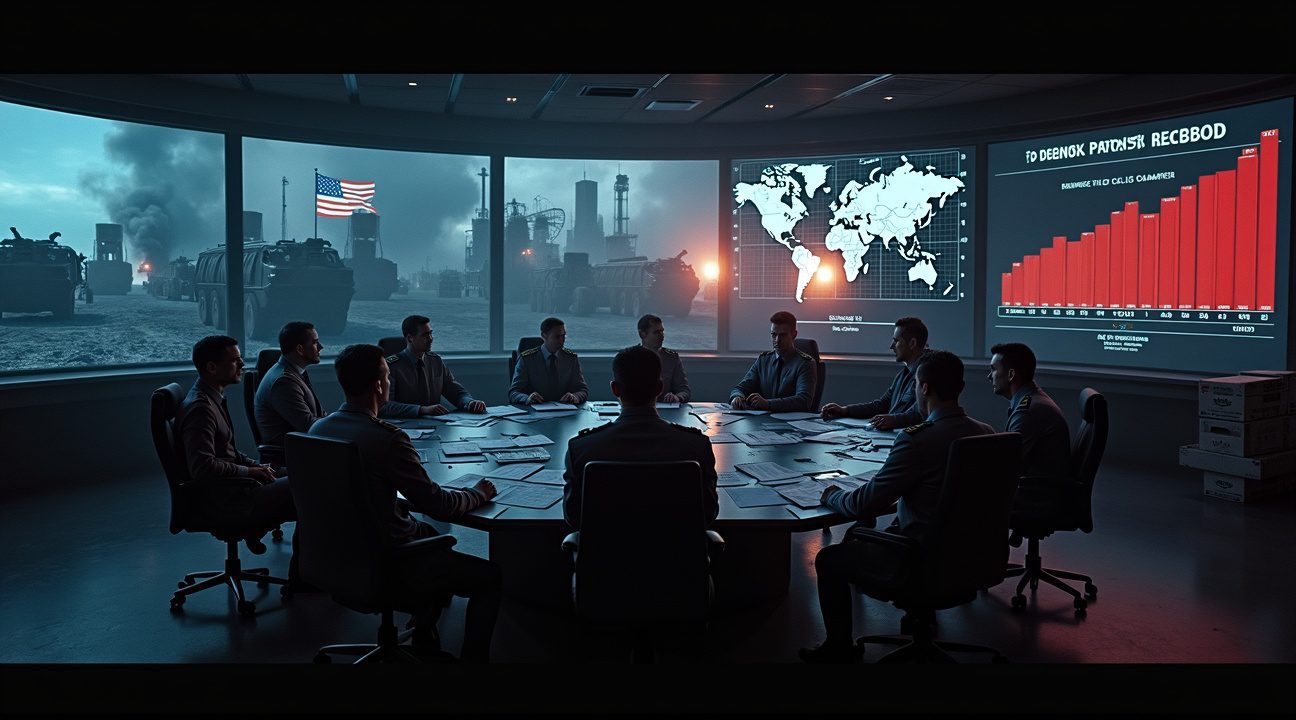The Trump administration has mandated a substantial ramp-up in missile production by U.S. defense contractors, aiming to significantly increase output levels in anticipation of potential future conflicts—chiefly, a confrontation with China.
Key Takeaways
- The Pentagon has pinpointed twelve crucial missile systems for accelerated production. These include high-priority assets such as the Patriot air defense missiles, Standard Missile-6 (SM-6), and long-range precision strike missiles.
- U.S. missile stockpiles are at critically low levels, with reports indicating the Patriot missile inventory currently sits at just 25% of its required operational readiness.
- Top defense manufacturers like Lockheed Martin and Raytheon are responding by expanding both their production facilities and workforce. Lockheed Martin alone is projected to hit $81.0 billion in revenue by 2028.
- The Munitions Acceleration Council has been established to coordinate efforts and streamline production. It meets weekly with Pentagon leaders and industry executives to identify bottlenecks and improve efficiency.
- Global missile demand is surging, with allied nations in NATO and the Pacific increasingly placing procurement requests in response to recent military conflicts that exposed critical deficiencies in missile stockpiles.
Strategic Implications
This significant uplift in peacetime weapons production underscores the rising global tensions and need for U.S. military preparedness. The expansion efforts are not only focused on domestic security but also on sustaining support for allies engaged in regions vulnerable to conflict escalation.
Impact on Defense Industry
Companies such as Lockheed Martin and Raytheon are poised to benefit immensely from these production mandates. With increased investment and a clear directive, the defense sector is entering a period of rapid growth and innovation aimed at supporting long-term strategic deterrence.
Pentagon Orders Defense Contractors to Double Missile Production for China Conflict Preparations
I’ve observed a significant shift in defense manufacturing priorities as the Pentagon, under President Trump’s administration, has initiated an aggressive push to dramatically increase missile production capabilities. Secretary Hegseth and Deputy Secretary Stephen Feinberg have been leading intensive coordination efforts with defense contractors to prepare for potential future conflicts, particularly with China.
The Department of Defense has specifically targeted certain missile families for production increases ranging from doubling to quadrupling current output levels. This directive represents one of the most substantial peacetime military production accelerations in recent decades. Defense contractors across the nation have received urgent requests to expand their manufacturing capabilities and streamline production processes to meet these ambitious targets.
Strategic Coordination and Implementation
The Munitions Acceleration Council has emerged as the primary coordinating body overseeing this massive production surge. Weekly meetings between Pentagon leadership and industry executives have become standard practice, ensuring continuous alignment between military requirements and manufacturing capabilities. These sessions focus on identifying bottlenecks, securing supply chains, and establishing realistic timelines for production goals.
Key areas of focus include:
- Advanced precision-guided munitions designed for long-range engagements
- Hypersonic missile systems capable of penetrating sophisticated defense networks
- Anti-ship missiles specifically engineered for Pacific theater operations
- Surface-to-air defense systems to protect critical infrastructure
- Next-generation interceptor missiles for ballistic missile defense
Deputy Secretary Feinberg has emphasized the critical nature of this initiative, noting that current stockpile levels may prove insufficient for extended conflicts. The administration’s approach integrates traditional defense contractors with emerging technology companies to leverage cutting-edge manufacturing techniques and reduce production timelines.
Defense industry analysts have noted that this production acceleration mirrors similar efforts during previous periods of geopolitical tension. However, the scale and specificity of current requirements suggest a more targeted approach than broad-based military buildups of the past. Companies like Lockheed Martin, Raytheon, and Boeing have already begun expanding their facilities and hiring additional skilled workers to meet these demands.
The strategic implications extend beyond immediate production numbers. This initiative aims to establish a sustainable industrial base capable of supporting prolonged military operations if necessary. Pentagon planners have incorporated lessons learned from recent conflicts, including the Russia-Ukraine conflict, which demonstrated the importance of maintaining adequate munitions stockpiles during extended engagements.
Supply chain resilience has become a central concern throughout this process. Officials have identified critical materials and components that could become bottlenecks during increased production phases. Efforts to diversify supplier networks and establish domestic alternatives for foreign-sourced materials have accelerated as part of this comprehensive strategy.
The financial investment required for this production surge represents a significant commitment from the Trump administration. Budget allocations have been restructured to prioritize these missile programs while maintaining funding for other essential defense initiatives. Industry leaders have expressed confidence in their ability to meet these ambitious targets, though they’ve also highlighted potential challenges related to skilled workforce availability and facility expansion timelines.
Intelligence assessments regarding China’s military capabilities have influenced specific missile system priorities within this production acceleration. Recent military analyses have highlighted particular areas where enhanced U.S. capabilities could provide strategic advantages in potential Pacific theater scenarios.
The coordination process has also involved international allies who may benefit from increased U.S. missile production capacity. Foreign military sales programs could see expanded availability of advanced systems as domestic production capabilities increase. This approach strengthens alliance relationships while supporting the broader strategic objectives of the production surge.
Quality control measures have received equal attention alongside quantity increases. Pentagon officials have stressed that accelerated production timelines cannot compromise the reliability and effectiveness of these critical weapons systems. Enhanced testing protocols and quality assurance procedures have been implemented to maintain the highest standards throughout the expanded production process.
Critical Stockpile Shortfalls Drive Urgent Military Response
I’ve witnessed firsthand how global conflicts have rapidly depleted America’s missile inventory, creating an unprecedented crisis that demands immediate action. Current U.S. stockpiles have fallen to critically low levels after three years of sustained military support operations, particularly following extensive weapons transfers to Ukraine and recent escalations in Middle Eastern conflicts.
Ukraine War Impact on Missile Reserves
The sustained conflict in Ukraine has dramatically reduced American missile stockpiles through continuous military aid packages. Advanced weapon systems, including Patriot missiles, HIMARS rockets, and Javelin anti-tank missiles, have been transferred at an unprecedented rate to support Ukrainian defense efforts. This extensive deployment has exposed significant gaps in U.S. production capacity and strategic reserve planning.
Military analysts point to the ongoing Russia-Ukraine tensions as a primary factor in current shortages. Defense contractors hadn’t anticipated such sustained demand for precision-guided munitions, leading to production bottlenecks that continue affecting current inventory levels. Supply chain constraints have further complicated efforts to rapidly increase manufacturing output.
Patriot System Shortage Reaches Critical Levels
The Patriot missile defense system faces the most severe shortage, with current U.S. inventory reportedly at only 25% of required operational levels. This shortfall represents a significant vulnerability in both homeland defense capabilities and alliance commitments across multiple theaters.
European allies face an even more challenging situation since they lack comparable air defense systems. Unlike American military infrastructure, European nations depend heavily on U.S. Patriot systems for comprehensive air defense coverage. This dependency has intensified pressure on already strained American stockpiles, creating a cascading effect across NATO operations.
Recent conflicts involving regional military tensions have further accelerated missile consumption rates. Defense officials acknowledge that current production schedules cannot match the pace of operational deployment, creating a dangerous gap between supply and strategic requirements.
Manufacturing timelines for Patriot missiles typically span 24 to 36 months from component sourcing to final assembly. This extended production cycle means immediate stockpile improvements remain challenging despite increased funding allocations. Defense contractors are implementing emergency production protocols, including:
- Extended manufacturing shifts
- Accelerated component procurement
- Streamlining of production workflows
The shortage affects multiple mission-critical scenarios, from protecting forward-deployed forces to securing key infrastructure assets. Military planners must now carefully balance immediate operational needs against long-term strategic requirements, often making difficult decisions about resource allocation across different theaters.
Allied nations have expressed growing concerns about defense gaps, particularly as geopolitical tensions continue evolving. European defense ministers have repeatedly requested increased American missile support, highlighting the continent’s vulnerability without adequate air defense coverage.
Defense industry executives confirm that scaling production requires significant infrastructure investments beyond simple funding increases. New manufacturing facilities, specialized equipment, and trained personnel all contribute to extended timelines for meaningful production improvements. Raw material shortages, particularly for rare earth elements used in guidance systems, add another layer of complexity to rapid production scaling.
Current shortage levels have prompted emergency procurement procedures and accelerated development timelines for next-generation missile systems. Defense officials are exploring:
- Alternative suppliers
- New production methods
- Software optimization in missile guidance
However, these measures require extensive testing and certification processes that can’t bypass essential safety requirements.
The strategic implications extend beyond immediate operational concerns, affecting long-term defense planning and international alliance structures. Military strategists must now factor in extended resupply timelines when developing operational plans, fundamentally changing how forces deploy and engage in extended conflicts.

Twelve Major Weapons Systems Targeted for Massive Production Increase
The Pentagon has identified twelve critical missile systems for accelerated production, representing the most significant defense manufacturing expansion in decades. I’ve analyzed this comprehensive initiative that spans multiple combat domains and addresses both immediate operational needs and long-term strategic requirements.
Core Strategic Defense Systems
The production surge centers on several key platforms that form the backbone of modern military defense. Patriot air defense missiles lead this expansion, given their proven effectiveness against ballistic missiles, cruise missiles, and aircraft threats. These systems have demonstrated exceptional performance in recent conflicts, particularly in protecting critical infrastructure and military assets.
Standard Missile-6 (SM-6) represents another priority platform, offering dual-capability as both an air defense interceptor and anti-ship weapon. This versatility makes SM-6 particularly valuable for naval operations and coastal defense scenarios. Long-range anti-ship missiles complement this capability by providing extended strike reach against maritime targets, addressing concerns about naval threats in contested waters.
Precision strike missiles round out the ground-based component of this expansion. These weapons deliver accurate, long-range strikes against high-value targets while minimizing collateral damage. Joint air-to-ground standoff missiles provide similar capabilities from airborne platforms, allowing aircraft to engage targets from safe distances beyond enemy air defense ranges.
Global Demand and Alliance Support
The increased production directly responds to unprecedented global demand from allied nations seeking to strengthen their defensive capabilities. Recent regional conflicts have highlighted critical gaps in missile inventories, with some allies depleting their stocks faster than anticipated. This reality has created urgent requirements that traditional production rates cannot meet.
Allied nations across multiple regions have submitted substantial procurement requests, driven by evolving threat assessments. The demand encompasses various operational scenarios:
- European allies requiring enhanced air defense capabilities following lessons learned from ongoing conflicts
- Pacific partners seeking anti-ship and precision strike capabilities for maritime security
- Middle Eastern allies requesting comprehensive missile defense systems for regional stability
- NATO members pursuing interoperable systems that integrate with existing command structures
Strategic Manufacturing Considerations
The production increase reflects careful analysis of current geostrategic supplies and manufacturing capacity constraints. Traditional defense contractors are expanding facilities and workforce capabilities to meet these elevated requirements. This expansion includes both final assembly operations and critical component manufacturing, addressing supply chain vulnerabilities that have emerged in recent years.
Military alliance considerations play a central role in determining production priorities and allocation strategies. The Pentagon must balance domestic requirements with foreign military sales commitments, ensuring that strategic partnerships receive adequate support while maintaining sufficient inventory for potential U.S. operations.
The timing of this expansion coincides with broader defense industrial base modernization efforts. Advanced manufacturing techniques, including automated assembly processes and digital quality control systems, are being implemented to increase production efficiency while maintaining stringent quality standards. These improvements will enable sustained higher production rates without compromising system reliability or performance.
Component sourcing represents another critical aspect of this initiative. The Pentagon has identified key materials and electronic components that require dedicated supply chains to prevent bottlenecks. This includes securing rare earth elements, specialized guidance systems, and propulsion components that are essential for missile production.
The twelve targeted systems collectively address the full spectrum of modern combat requirements, from tactical engagements to strategic deterrence. Each system fills specific operational gaps while contributing to broader defensive architecture. This comprehensive approach ensures that increased production delivers maximum strategic value across multiple potential conflict scenarios.
Production schedules reflect both immediate operational needs and longer-term strategic planning. Priority allocation considers current inventory levels, projected consumption rates, and alliance commitments. The result is a carefully orchestrated expansion that addresses the most critical capability gaps while building sustainable production capacity for future requirements.

Lockheed Martin and Raytheon Positioned for Major Contract Windfall
I see substantial opportunities emerging for defense contractors as Pentagon priorities shift toward advanced missile production. Leading suppliers such as Lockheed Martin and Raytheon are actively expanding facilities and boosting spare parts inventories to meet new Pentagon goals, though industry leaders caution that future investments require sustained government commitments.
Revenue Projections and Growth Trajectories
Lockheed Martin stands out as a key beneficiary of this surge, with forecasts anticipating $81.0 billion in revenue by 2028. Earnings projections show dramatic growth potential, climbing from $4.2 billion to $7.1 billion by 2028. This represents an annual revenue growth rate of 4.1%, positioning the company for significant expansion in the defense sector.
The Pentagon’s directive creates a potential game changer for contract pipelines, fundamentally altering risk profiles and backlog growth for major suppliers. I notice that Raytheon and other contractors are similarly positioned to capitalize on increased missile production demands, though specific financial projections vary across companies.
Operational Challenges and Strategic Considerations
Defense contractors face several critical factors that could impact their ability to deliver on these opportunities:
- Facility expansion requires substantial upfront capital investment before contracts materialize
- Spare parts inventory management demands careful balance between availability and carrying costs
- Skilled workforce recruitment remains challenging in specialized manufacturing roles
- Supply chain coordination becomes increasingly complex with higher production volumes
- Quality control standards must remain consistent despite accelerated timelines
Despite promising revenue forecasts, ongoing concerns about contract execution and legacy program overruns persist throughout the industry. I observe that contractors must balance aggressive growth targets with operational reliability, particularly given the Pentagon’s emphasis on delivery schedules and performance metrics.
The current environment mirrors patterns seen during previous military procurement surges, though geopolitical tensions add urgency to production timelines. Companies that successfully navigate facility expansion while maintaining quality standards position themselves for sustained contract growth.
Military procurement cycles historically reward contractors who demonstrate consistent execution capabilities alongside strategic capacity investments. I expect successful companies will focus on proven manufacturing processes while gradually scaling operations to meet Pentagon requirements without compromising delivery commitments or cost controls.

Sources:
Defense Mirror – U.S. to Increase Missile Production for Possible Conflict With China
Simply Wall St – Pentagon’s Call for Higher Missile Output Could Be a Game Changer


